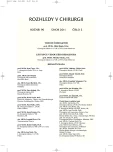Early Biliary Complications Following Liver Transplantation
Authors:
M. Kučera; M. Adamec; M. Oliverius; L. Janoušek; M. Kočík; J. Špičák 1; P. Štirand 1; P. Drastich 1; J. Peregrin 2; P. Trunečka 3
Authors‘ workplace:
Klinika transplantační chirurgie, IKEM, Praha, přednosta: prof. MUDr. Miloš Adamec, CSc.
; Klinika hepatogastroenterologie, IKEM, Praha, přednosta: prof. MUDr. Julius Špičák, CSc.
1; Pracoviště radiodiagnostiky a intervenční radiologie, IKEM, Praha, přednosta: prof. MUDr. Jan Peregrin, CSc.
2; Transplantcentrum, IKEM, Praha, přednosta: MUDr. Pavel Trunečka, CSc.
3
Published in:
Rozhl. Chir., 2011, roč. 90, č. 2, s. 117-121.
Category:
Monothematic special - Original
Overview
Introduction:
Biliary complications (BC) after liver transplantation (LTx) are serious problems with an incidence rate of 6–35%. There are two types of BC, early and late. Early BC is observed for 30 days post LTx or during the entire period of the patient’s first hospital stay after LTx. The main causes of early BC are ischemia of the biliary tree (the bile duct of the transplanted liver is supplied only from the right hepatic artery descendingly; the supply from the gastroduodenal artery is lacking) as well as implementation of the biliary anastomosis surgical technique. Treatment of BC is administered by a surgeon, a gastroenterologist and a radiologist.
Aim:
To evaluate early biliary complications after LTx
Patients and methods:
We reviewed patients with early BC after LTx from 4/2004 – 12/2009. We defined early BC as a complication that is present during the first 30 days post LTx or during the entire period of the patient’s first hospital stay after LTx.
Results:
We performed 384 LTx during the above-mentioned period. We carried out reconstruction of the biliary tree in the form of a choledochocholedochostomy (CDD) in 312 cases and in the form of a choledochojejunostomy (CDJ) in 72 cases. Sixty-eight patients had early BC (17.7%), 25 patients experienced biliary leak (6.5%), 40 patients had anastomotic stenosis (10.4%) and 3 patients (0.8%) experienced both complications (biliary leak and stenosis). Most complications were eliminated by ERCP with a papilosfincterotomy, a balloon dilatation of stenosis, and a biliary stent implant with repeated stent replacements (45 cases in total - all patients with biliary stenosis). Twenty-two patients were reoperated on (16x CDJ, 3x re-CDD, 2x suture of aberrant bile duct, 1x suture common bile duct) and 1 patient was treated by percutaneous transhepatic bilary drainage (PTD). The mortality rate was zero.
Conclusion:
BC after LTx continue to pose a serious surgical problem. The treatment of choice when dealing with BC is ERCP, which has more than a 70% success rate. If ERCP or PTD are not successful, or when biliary peritonitis is present, we perform a reanastomosis of the bile duct. The combined effort of the surgeon, gastroenterologist and radiologist is the most important factor for successful treatment. The incidence of BC after LTx at IKEM is similar to that of treatment centers all over the world.
Key words:
liver transplantation – early biliary complications – endoscopic treatment – surgical treatment
Sources
1. Verdonk, R. C., Buis, C. I., Porte, R. J., Haagsma, E. B. Biliary complications after liver transplantation: a review. Scand. J. Gastroenterol. Suppl., 2006, May; (243): 89–101.
2. Wojcicki, M., Milkiewicz, P., Silva, M. Biliary tract complications after liver transplantation: a review. Dig. Surg., 2008; 25(4): 245–257.
3. Pascher, A., Neuhaus, P. Biliary complications after deceased-donor orthotopic liver transplantation. J. Hepatobiliary Pancreat. Surg., 2006; 13(6): 487–496.
4. Scanga, A. E., Kowdley, K. V. Management of biliary complications following orthotopic liver transplantation. Curr. Gastroenterol. Rep., 2007, Mar; 9 (1): 31–38.
5. Sharma, S., Gurakar, A., Jabbour, N. Biliary strictures following liver transplantation: past, present and preventive strategies. Liver Transpl., 2008.
6. Duailibi, D. F., Ribeiro, M. A. Jr. Biliary complications following deceased and living donor liver transplantation: a review. Transplant. Proc., 2010 Mar; 42(2): 517–520.
7. Riediger, C., Müller, M. W., Michalski, C. W., Hüser, N., Schuster, T., Kleeff, J., Friess, H. T-Tube or no T-tube in the reconstruction of the biliary tract during orthotopic liver transplantation: systematic review and meta-analysis. Liver Transpl., 2010, Jun; 16(6): 705–717. Review.
8. Wojcicki, M., Lubikowski, J., Klek, R., Post, M., Jarosz, K., Białek, A., Wunch, M., Czuprynska, M. Reduction of biliary complication rate using continuous suture and no biliary drainage for duct-to-duct anastomosis in whole-organ liver transplantation. Transplant. Proc., 2009, Oct; 41 (8): 3126–3130.
9. Schmitz, V., Neumann, U. P., Puhl, G., Tran, Z. V., Neuhaus, P., Langrehr, J. M. Surgicalcomplications and long-term outcome of different biliary reconstructions in livertransplantation for primary sclerosing cholangitis-choledochoduodenostomy versus choledochojejunostomy. Am. J. Transplant., 2006, Feb; 6 (2): 379–385.
10. Bennet, W., Zimmerman, M. A., Campsen, J., Mandell, M. S., Bak, T., Wachs, M., Kam, I. Choledochoduodenostomy is a safe alternative to Roux-en-Y choledochojejunostomy for biliary reconstruction in liver transplantation. World J. Surg., 2009, May; 33(5): 1022–1025.
11. Alexopoulos, S. P., Henningsen, J. A., Jeffrey, R. B., Bonham, C. A., Ahmed, A., Gonzalez, S. A. Management of biliary strictures following liver transplantation. Dig. Dis. Sci., 2009 Jan; 54 (1): 25–27.
12. Holt, A. P., Thorburn, D., Mirza, D., Gunson, B., Wong, T., Haydon, G. A prospective study of standardized nonsurgical therapy in the management of biliary anastomotic strictures complicating liver transplantation. Transplantation, 2007, Oct 15; 84 (7): 857–863.
13. Aytekin, C., Boyvat, F., Harman, A., Ozyer, U., Sevmi, S., Haberal, M. Percutaneous management of anastomotic bile leaks following liver transplantation. Diagn. Interv. Radiol., 2007, Jun; 13 (2): 101–104.
14. Mercado, M. A., Vilatobá, M., Chan, C., Domínguez, I., Leal, R. P., Olivera, M. A. Intrahepatic bilioenteric anastomosis after biliary complications of liver transplantation: operative rescue of surgical failures. World J. Surg., 2009, Mar; 33(3): 534–538.
Labels
Surgery Orthopaedics Trauma surgeryArticle was published in
Perspectives in Surgery

2011 Issue 2
Most read in this issue
- Early Biliary Complications Following Liver Transplantation
- Outcomes of Combined Mitral Valve Repair Surgery and Aortic Valve Replacement in IKEM Praha
- Cardiosurgical Procedures in Patients Refusing Blood Transfusions: IKEM Outcomes
- Development of Pancreas Transplantation Surgical Techniques in IKEM
